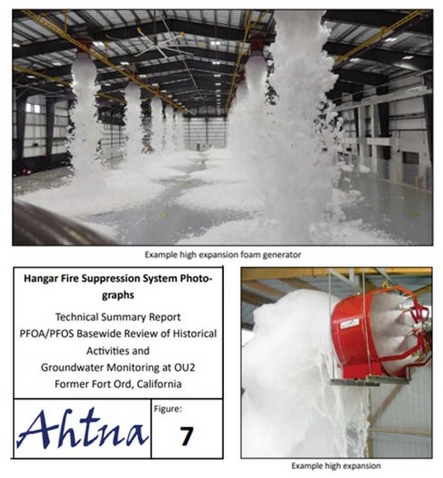
By Pat Elder
From MilitaryPoisons.org | Original Article
Who knew? Who cares? Army report says eight hangars had suppression systems like these. There was an accidental discharge of foam from the fire suppression system in one hangar which resulted in more than five feet of foam covering the floor of the hangar.
In early November, 2022 the Agency for Toxic Substances and Disease Registry (ATSDR) announced it would be launching a new study to examine why so many veterans stationed at Fort Ord, California have died prematurely and many more have suffered serious illnesses. An ATSDR report in 1996 dismissed the health concerns associated with contamination on the base. Like hundreds of US military installations throughout the country and around the world, Fort Ord, an Army base that was shut down in 1994, is dangerously contaminated with a host of toxins that may continue to threaten public health.
The announcement by the federal agency comes nine months after an impressive investigation by the Associated Press, (AP), thatfound drinking water at the poisoned outpost contained a host of deadly chemicals, most notably cancer-causing trichloroethylene, (TCE).
Although the AP investigation detailed multiple Army reports, it neglected to cover the Army’s Basewide Review on Perfluorooctanoic Acid (PFOA) and Perfluorooctane Sulfonate (PFOS), prepared by Ahtna Environmental on February 27, 2020.
California says PFOA and PFOS cause cancer.
ATSDR’s report 26 years ago also neglected to mention the presence of PFAS at Fort Ord. The DOD has known of the staggering impact these chemicals have on human health since the early 1970’s. Meanwhile, the Army has been covering up the extent and severity of PFAS contamination, according to EPA investigators.
PFOA was found in groundwater at 113 parts per trillion, (ppt). The EPA says it’s dangerous to consume groundwater above .004 ppt of PFOA. (113 / .004 = 28,250) The chemicals in the ground at Fort Ord are 28,250 times over the EPA limit.
PFOS was found in groundwater at 447 ppt. The EPA’s threshold is .02 ppt.
(447 / .02 = 22,350). PFOS in the ground at Fort Ord is 22,350 times over the EPA limit.
The tests were conducted in 2019. Soldiers and their families stationed at Fort Ord were likely drinking water poisoned with PFAS.
PFAS exposure has been linked to the following cancers, while intensive studies are ongoing, (See the links below)
Bladder cancer y
Breast cancer z
Colon cancer y
Esophageal cancer y
Kidney Cancer x
Liver w
Mesothelioma y
Multiple Myeloma u
Non-Hodgkin Lymphoma and Thyroid Cancer x
Ovarian and Endometrial Cancer x
Pancreatic cancer v
Prostate cancer x
Testicular cancer x
Thyroid cancer x
u National Library of Medicine – EHP
v PFAS Central.org
w Chemical and Engineering News
x National Cancer Institute
y National Library of Medicine – PubMed
z Breast Cancer Prevention Partners
I tried to tell folks in 2020
I addressed PFAS contamination at Fort Ord during a presentation I gave on March 11, 2020 to the Monterey Peace and Justice Center in Seaside. I told the three dozen who came out in the earliest days of the pandemic about the PFAS contamination at Fort Ord. Veterans from the base attended the meeting and talked about their health issues. My colleagues with Military Poisons and the Women’s International League for Peace and Freedom reached out to regional press from Santa Barbara to San Jose. No one was interested in covering the story.
Actually, the Monterey County Weekly published a story six weeks later that reads like it had been written by the Army’s Base Realignment and Closure Division, (BRAC). Lines from the story follow a familiar propagandistic pattern:
- “These chemicals were introduced to Monterey County soil and groundwater when Fort Ord was still an active installation, but the military says that the risk to public health here is low.”
- The presence of PFAS is not that extensive,” says William Collins, environmental coordinator of the military’s local Base Realignment and Closure office.
- “Where we found PFAS, it is being removed.”
- “The report shows no indication that the toxic PFAS chemicals from Fort Ord entered the region’s supply of drinking water.”
- A water treatment facility built in the 1990s to clean up trichloroethane in the aquifer also happened to catch PFAS, he says: “The good news is that where we found PFAS, it is being removed.”
======
LA Progressive picked up my May, 2020 article, The Army Contaminates Fort Ord Region with PFAS and Downplays Health Impacts. I’m not reporting anything new today.
It seems that few are overly concerned about PFAS, aside from a few hundred here and there who are sick and dying – and who are associated with military bases where veterans have started Facebook groups to educate and organize victims. Perhaps a few more people have heard about PFAS today.

Julie Akey arrived at Fort Ord in 1996 at age 25. She drank the water and ate the vegetables she watered with the base’s water supply. 21 years later, at age 46, she was diagnosed with multiple myeloma, a blood disease where cancerous plasma cells accumulate in the bone marrow. Trichloroethylene, (TCE) is held as a likely suspect because it is linked to multiple myeloma. TCE is mentioned a dozen times in the AP report. PFAS is also linked to multiple myeloma but it is never mentioned.
In June of 2019, Julie started the Facebook group, Cancer and illness from Fort Ord, CA military base People have flocked to the group. Julie has collected information on nearly 900 people who lived at Fort Ord and were later diagnosed with cancer and various illnesses.
There are great women like Julie across the country, and you know, it’s almost always the women who rise up.

Camp Lejeune – a public relations success for the DOD?
There are lessons we can learn from Camp Lejeune, a place with astronomical levels of PFAS in groundwater.
It’s all hush. The much ballyhooed Pact Act, which offers compensation for Marines and their families stationed at Lejeune during a relatively brief period of time, leaves PFAS out of the deal.
It could break the bank. The Pact Act is turning out to be a propaganda victory for the DOD. Go figure.

The Department of Veterans Affairs knows all about PFAS. They’re telling vets not to worry and they discourage blood testing for the chemicals even though the National Academies of the Sciences is urging people with the likelihood of exposure to get tested. From the VA:
“VA does not recommend blood tests to determine levels of PFAS in any individual. This is because most people in the U.S. have measurable amounts of PFAS in their blood and normal ranges have not been established. Also, blood tests cannot be linked to current or future health conditions or guide medical treatment decisions.”
The VA is way off base here. The National Academies of Sciences has given clinicians advice on what to do when PFAS concentrations reach certain levels in the blood. See their Guidance on PFAS Testing and Health Outcomes. If servicemembers at Fort Ord had military occupational specialties that included firefighting, engine degreasing, or chrome plating they ought to consider having their blood tested for a host of PFAS compounds and they ought to seek professional medical and legal advice. Others who are sick and think their illnesses may have been caused by drinking the water or other pathways to exposure as a result of the time they spent at Fort Ord, should do the same.
Table 3 – Fort Ord Technical Summary Report, PFAS
Table 3 from the Army’s ignored report shows the concentrations of PFOA and PFOS in ug/L. That is micrograms per liter, or parts per billion. To arrive at parts per trillion (ppt), we have to multiply by 1,000, so the levels are 113 ppt for PFOA and 447 ppt for PFOS.
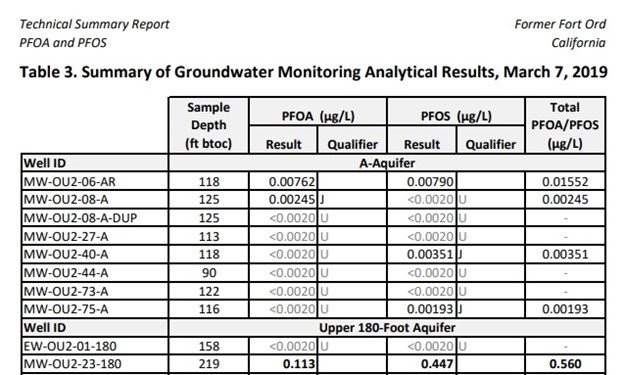
We can’t trust the Army. This is all they’re willing to tell us. The Army has only made 19 testing results public and they’re only from three general areas. Let’s compare the Army’s Fort Ord to Travis Air Force Base. The Final Site Inspection for AFFF Areas at Travis AFB examined 181 sites for PFAS. They provided results for 128 soil samples, 7 sediment samples, 44 from groundwater and 2 from process water. They examined PFAS levels in several media at various fire training areas, hangars, surface water outfalls, fire stations, crash sites, nozzle spray areas, wastewater treatment plants, and sludge disposal areas. Travis reported that AFFF Area 5 had 410,000 ppt of PFOS and 29,000 ppt of PFOA. These concentrations are 20.5 million times over the EPA limit for PFOS and 7.25 million times over the EPA threshold for PFOA.
Should we step back and say things aren’t so bad at Fort Ord compared to Travis AFB, or should we demand accountability and transparency from the Army? Take your pick. The contamination is likely to be much, much worse at Fort Ord, at least that’s the takeaway from the EPA commentary on the Ahtna report commissioned by the Army.

Below is a snapshot of the 14 EPA General Comments from the report on PFAS at Fort Ord. EPA scientists have laid it out so we can understand it, for the most part. The Army report focuses largely on the use of PFAS chemicals in firefighting foams while the Army actually has multiple uses for the compounds that endanger public health. This is the Army’s most recent public commentary regarding PFAS contamination at Fort Ord.
The EPA’s commentary describes the Army’s obfuscation regarding the specific severity and extent of PFAS contamination on the Fort Ord installation. This is particulalry disturbing considering the proven associations between PFAS and several types of cancer while there are many documented cases of cancer among service members who served at Fort Ord.
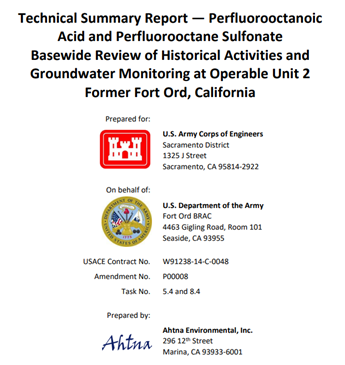
EPA GENERAL COMMENT 1: The Draft PFAS Report does not adhere to the investigative process identified in the Army Guidance for Addressing Releases of Per- and Polyfluoroalkyl Substances (PFAS), dated September 2018. Please revise the Draft PFAS Report to follow the procedures listed in the Army PFAS Guidance.
EPA GENERAL COMMENT 2: The Draft PFAS Report is missing information about migration pathways and exposure pathways.
EPA GENERAL COMMENT 3: The Draft PFAS Report contains insufficient site descriptions, operational histories, and waste characteristics for each site. (things like nearby drinking water wells, residences, and other sensitive receptors (schools, daycares, hospitals, etc.).
EPA GENERAL COMMENT 4: The Draft PFAS Report should include site-specific figures for each of the 52 sites assessed. A site-specific figure displaying the location of relevant site features (e.g., AFFF storage areas, floor drains, suspected runoff areas, etc.) should be included for each site evaluated.
EPA GENERAL COMMENT 5: The Draft PFAS Report should provide a photographic log for each site evaluated. The photographic log should include a description of pertinent features identified during the site reconnaissance at each site (e.g., surface water flow direction, drainage structures, surface covers).
EPA GENERAL COMMENT 6: The Draft PFAS Report includes figures indicating a general groundwater flow direction at the sites proposed for further evaluation; however, it is unclear if the groundwater flow directions are known or estimated for each site evaluated. Please clarify whether groundwater flow directions are known or estimated for each site evaluated. If known, provide groundwater elevation data and potentiometric surface maps or a reference to such data to support such statements.
EPA GENERAL COMMENT 7: The Draft PFAS Report should discuss whether any foaming of the runway(s) or foam salutes occurred at the installation. Foaming of the runway was an aviation safety practice that consisted of spreading a layer of fire suppression foam on an airport runway to prevent fires prior to an emergency landing while a foam salute is a celebratory practice that consists of spraying two streams of AFFF to create an arch that planes would pass under during inaugural or final flights.
EPA GENERAL COMMENT 8: The Draft PFAS Report regularly refers to personal communication with the former Chief of the Monterey Fire Department, Mr. Jack Riso. Yet, documentation of these interviews are not provided. As a result, the information obtained from Mr. Riso cannot be substantiated.
EPA GENERAL COMMENT 9: Contaminated soil within Operable Unit 1 – FAAF Fire Drill Area was treated in 1988 using an aqueous nutrient formulation to stimulate microbial degradation of the hydrocarbons in the soil and was then transported to a soil borrow area for use as fill in construction projects at the former Fort Ord. As a result, the soil borrow area and the sites where the fill was used are potential PFAS contaminated sites. Revise the Draft PFAS Report to recommend further evaluation of Operable Unit 1 – FAAF Fire Drill Area and potential sites of fill use.
EPA GENERAL COMMENT 10: Aerial photographs and property records were reviewed, and personnel interviews were conducted as part of the Preliminary Assessment for Site 20 – South Parade Ground and 3800 and 519th Motor Pools. However, these records and interviews are not included in the Draft PFAS Report to substantiate the decision to eliminate this site from further evaluation.
EPA GENERAL COMMENT 11: The Draft PFAS Report states that contaminated soils from Sites 8 (Range 49,Molotov Cocktail Range), 10 (Burn Pit/Fire Training Area), and 40 (FAAF Helicopter Defueling Area) were transported to the Fort Ord Soil Treatment Area (FOSTA) for treatment; however, the FOSTA was not included in the 52 sites evaluated. In addition, information on how soils were treated at the FOSTA are not provided and/or referenced.
EPA GENERAL COMMENT 12: The Draft PFAS Report does not include any information on the location(s) of fire stations or AFFF storage. While the burn pit and fire training area at the Fort Ord Fire Station is discussed in Section 2.1.2 (Site 10 – Burn Pit/Fire Training Area), no fire stations were evaluated, and the twelve sites identified as potential AFFF storage sites did not store AFFF. Given that AFFF was used onsite, please revise the Draft PFAS Report to include assessments of fire stations and AFFF storage locations.
EPA GENERAL COMMENT 13: The Draft PFAS Report should summarize data for all PFAS analytes, not just PFOA and PFOS, detected in the narrative of the report.
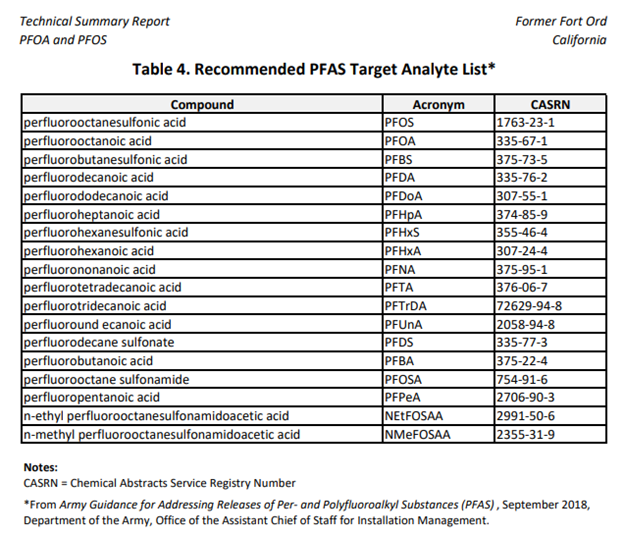
EPA GENERAL COMMENT 14: Throughout the Draft PFAS Report, the analysis of the PFAS detections should be based on the screening levels identified in the October 15, 2019 DOD Investigating Per- and Polyfluoroalkyl Substances within the Department of Defense Cleanup Program (e.g., 40 ppt PFOA and PFOS, individual, if multiple PFAS are detected) as well as the EPA Health Advisory Level of 70 ppt for groundwater that is a current or potential source of drinking water. (Note: the EPA Health Advisory is now .004 for PFOA and .02 for PFOS)
=======
Overhead suppression systems at Fort Ord
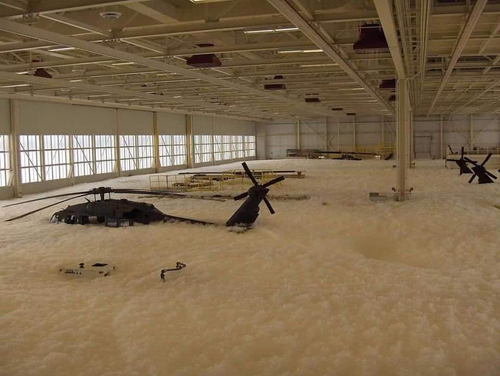
Guard personnel were testing the base’s alarm system when something triggered the suppression foam equipment at Tulsa’s Army National Guard base.
– Defense Visual Information Distribution Service
According to the Ahtna Technical Summary Report, there were eighteen sites identified at the former Fort Ord where AFFF may have been used or stored as part of a fire suppression system. Eight of these sites were aviation hangars. Aviation hangars are of interest because AFFF may have been used in the fire suppression systems and a release may have occurred.
There was an accidental discharge of foam from the fire suppression system in one hangar which resulted in more than five feet of foam covering the floor of the hangar. Cleanup after the accidental discharge could have resulted in AFFF being discharged to surface drainage channels or sanitary sewer system, and a suspected release of PFAS at stormwater infiltration areas south of Building 507.
An inspection of the interior of Building 507 indicated the presence of a possible foam suppression system in the helicopter maintenance (hangar) area and an adjacent storage/workshop area.
Unlike the Army, the Air Force is not bashful about identifying carcinogenic, PFAS-loaded overhead foam systems. For instance, Beale AFB, north of Sacramento, readily identifies 6 current overhead suppressions systems that have used AFFF. The Air Force hasn’t done much, if anything, however, to clean up the mess it has caused at Beale.

Apparently, the Army can say and do whatever it wants. The EPA Region 9 investigators providing this commentary are professional public servants. Sadly, EPA leadership knows what’s going on across the country but does little to force DOD branches to take steps to actually protect public health. The DOD dictates environmental policy in the United States of America.
The less the Army discloses, the less liability it is likely to have. These carcinogens are killers and the local community, as well as thousands of soldiers and their families who drank the poisoned water and were exposed to the chemicals, are largely clueless.
ATSDR environmental assessments of other bases have documented dangerous carcinogenic dust in homes and high levels of the compounds in residents’ blood. These levels have been found to be correlated with concentrations of PFAS in groundwater and surface water on bases. See this report on Shepherd Field Air National Guard base in Martinsburg, West Virginia.

The AP investigation earlier this year points to instances of contamination that we know from the Army’s report actually involved PFAS. Consider this segment from the investigation:
======
On Fridays, crews would forklift barrels of the used flammable liquids down a bumpy sandy road, dumping solvents, paint and metal chips onto the hulks of broken aircraft and tanks at a burn pit. One weekend a month, airfield firefighters would light up the toxic sludge and then douse the roaring fires with foam. In 1984, an anonymous caller tipped off Fort Ord’s officials that “approximately 30 55-gallon drums,” containing about 600 gallons of a “solvent-type liquid” had been illegally spilled there, an Army report said. The report said the site had been in use for 22 years.
The Technical Summary Report Sec. 2.1.6 Operable Unit 1 – FAAF FDA (Fritzsche Army Airfield Fire Drill Area) addresses the same location on base:
The FAAF FDA was established in 1962 as a training area for the Fort Ord Fire Department west of FAAF. As part of training activities, waste fuel (primarily composed of outdated or water contaminated JP-4) was discharged from an onsite storage tank into a pit, ignited, and then extinguished. Other fuels included hydraulic and lubrication oils, gasoline, diesel, and solvents.
After 1972, Aqueous Film-Forming Foam (AFFF) was used during training activities to extinguish fires in the FDA, with training occurring at least once per quarter (i.e., four times per year) and 100 to 200 gallons of AFFF being used during each training event (Riso, 2019a).
Training activities at the Fire Drill Area were discontinued in 1985 and the associated structures (pipeline and storage tank) were removed. These training activities are believed to have resulted in the release of contaminants to soil and groundwater.
========
The Agency for Toxic Substances and Disease Registry (ATSDR) ought to be commended for taking on this project, even though it has taken the federal government 26 years to get around to it. Let’s make sure they get it right on the PFAS contamination.
It’s a sad reality, but members of the sickened Fort Ord community must advocate for themselves. People should research these extraordinarily deadly PFAS chemicals. PFAS takes nearly forever to break down and they bioaccumulate in our bodies. The National Academies of Sciences finds evidence of association between PFAS exposure and increased risk of disease. A PFAS blood test can provide clinicians with critical information.
What’s in your blood?
Special thanks to the Downs Law Group for their continued financial support. The firm is providing free blood testing to individuals like firefighters and others with a high likelihood of exposure to PFAS.
Military Poisons and the Women’s League for Peace and Freedom are continuing to raise funds to cover the costs of PFAS water and seafood testing. You can make a tax-deductible contribution here.
